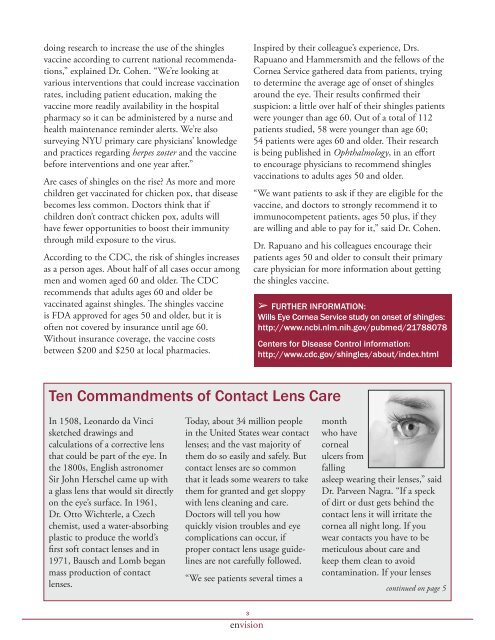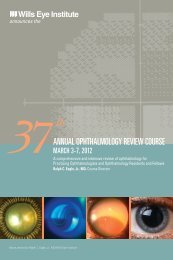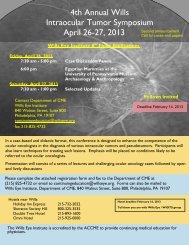Envision Newsletter - Wills Eye
Envision Newsletter - Wills Eye
Envision Newsletter - Wills Eye
Create successful ePaper yourself
Turn your PDF publications into a flip-book with our unique Google optimized e-Paper software.
doing research to increase the use of the shingles<br />
vaccine according to current national recommendations,”<br />
explained Dr. Cohen. “We’re looking at<br />
various interventions that could increase vaccination<br />
rates, including patient education, making the<br />
vaccine more readily availability in the hospital<br />
pharmacy so it can be administered by a nurse and<br />
health maintenance reminder alerts. We’re also<br />
surveying NYU primary care physicians’ knowledge<br />
and practices regarding herpes zoster and the vaccine<br />
before interventions and one year after.”<br />
Are cases of shingles on the rise? As more and more<br />
children get vaccinated for chicken pox, that disease<br />
becomes less common. Doctors think that if<br />
children don’t contract chicken pox, adults will<br />
have fewer opportunities to boost their immunity<br />
through mild exposure to the virus.<br />
According to the CDC, the risk of shingles increases<br />
as a person ages. About half of all cases occur among<br />
men and women aged 60 and older. e CDC<br />
recommends that adults ages 60 and older be<br />
vaccinated against shingles. e shingles vaccine<br />
is FDA approved for ages 50 and older, but it is<br />
often not covered by insurance until age 60.<br />
Without insurance coverage, the vaccine costs<br />
between $200 and $250 at local pharmacies.<br />
Inspired by their colleague’s experience, Drs.<br />
Rapuano and Hammersmith and the fellows of the<br />
Cornea Service gathered data from patients, trying<br />
to determine the average age of onset of shingles<br />
around the eye. eir results confirmed their<br />
suspicion: a little over half of their shingles patients<br />
were younger than age 60. Out of a total of 112<br />
patients studied, 58 were younger than age 60;<br />
54 patients were ages 60 and older. eir research<br />
is being published in Ophthalmology, in an effort<br />
to encourage physicians to recommend shingles<br />
vaccinations to adults ages 50 and older.<br />
“We want patients to ask if they are eligible for the<br />
vaccine, and doctors to strongly recommend it to<br />
immunocompetent patients, ages 50 plus, if they<br />
are willing and able to pay for it,” said Dr. Cohen.<br />
Dr. Rapuano and his colleagues encourage their<br />
patients ages 50 and older to consult their primary<br />
care physician for more information about getting<br />
the shingles vaccine.<br />
‚ FuRTHER InFoRmATIon:<br />
<strong>Wills</strong> <strong>Eye</strong> Cornea Service study on onset of shingles:<br />
http://www.ncbi.nlm.nih.gov/pubmed/21788078<br />
Centers for Disease Control information:<br />
http://www.cdc.gov/shingles/about/index.html<br />
Ten Commandments of Contact Lens Care<br />
In 1508, Leonardo da Vinci<br />
sketched drawings and<br />
calculations of a corrective lens<br />
that could be part of the eye. In<br />
the 1800s, English astronomer<br />
Sir John Herschel came up with<br />
a glass lens that would sit directly<br />
on the eye’s surface. In 1961,<br />
Dr. Otto Wichterle, a Czech<br />
chemist, used a water-absorbing<br />
plastic to produce the world’s<br />
first soft contact lenses and in<br />
1971, Bausch and Lomb began<br />
mass production of contact<br />
lenses.<br />
Today, about 34 million people<br />
in the United States wear contact<br />
lenses; and the vast majority of<br />
them do so easily and safely. But<br />
contact lenses are so common<br />
that it leads some wearers to take<br />
them for granted and get sloppy<br />
with lens cleaning and care.<br />
Doctors will tell you how<br />
quickly vision troubles and eye<br />
complications can occur, if<br />
proper contact lens usage guidelines<br />
are not carefully followed.<br />
“We see patients several times a<br />
month<br />
who have<br />
corneal<br />
ulcers from<br />
falling<br />
asleep wearing their lenses,” said<br />
Dr. Parveen Nagra. “If a speck<br />
of dirt or dust gets behind the<br />
contact lens it will irritate the<br />
cornea all night long. If you<br />
wear contacts you have to be<br />
meticulous about care and<br />
keep them clean to avoid<br />
contamination. If your lenses<br />
continued on page 5<br />
3<br />
envision






